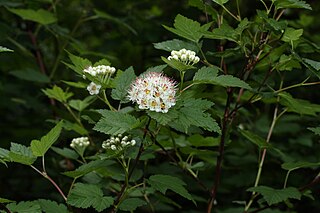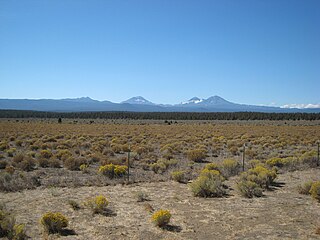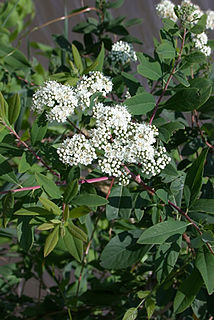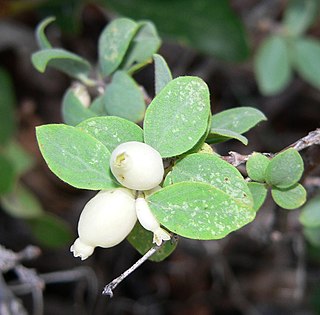| Physocarpus malvaceus | |
|---|---|
 | |
| Scientific classification | |
| Kingdom: | Plantae |
| Clade: | Angiosperms |
| Clade: | Eudicots |
| Clade: | Rosids |
| Order: | Rosales |
| Family: | Rosaceae |
| Genus: | Physocarpus |
| Species: | P. malvaceus |
| Binomial name | |
| Physocarpus malvaceus | |
Physocarpus malvaceus is a species of flowering plant in the rose family known by the common name mallow ninebark. It is native to western North America, where its distribution extends from British Columbia to Nevada to Wyoming. [2]

The flowering plants, also known as angiosperms, Angiospermae or Magnoliophyta, are the most diverse group of land plants, with 64 orders, 416 families, approximately 13,164 known genera and c. 369,000 known species. Like gymnosperms, angiosperms are seed-producing plants. However, they are distinguished from gymnosperms by characteristics including flowers, endosperm within the seeds, and the production of fruits that contain the seeds. Etymologically, angiosperm means a plant that produces seeds within an enclosure; in other words, a fruiting plant. The term comes from the Greek words angeion and sperma ("seed").

Rosaceae, the rose family, is a medium-sized family of flowering plants, including 4,828 known species in 91 genera.

British Columbia is the westernmost province of Canada, located between the Pacific Ocean and the Rocky Mountains. With an estimated population of 5.016 million as of 2018, it is Canada's third-most populous province.
This plant is a deciduous shrub usually growing up to 2.1 meters tall, [2] sometimes reaching 3 meters. [3] It can form dense thickets. The branches are hairless, and older ones have shreddy bark. The leaves have three to five lobes and serrated edges. Dark green when mature, they turn brownish red by early fall. The inflorescence is a corymb of flowers that have white petals measuring about 4 millimeters in length. The fruit is a follicle roughly one centimeter long. [2] [3] [4]

A shrub or bush is a small- to medium-sized woody plant. Unlike herbaceous plants, shrubs have persistent woody stems above the ground. They are distinguished from trees by their multiple stems and shorter height, and are usually under 6 m (20 ft) tall. Plants of many species may grow either into shrubs or trees, depending on their growing conditions. Small, low shrubs, generally less than 2 m (6.6 ft) tall, such as lavender, periwinkle and most small garden varieties of rose, are often termed "subshrubs".

A thicket is a very dense stand of trees or tall shrubs, often dominated by only one or a few species, to the exclusion of all others. They may be formed by species that shed large numbers of highly viable seeds that are able to germinate in the shelter of the maternal plants.

An inflorescence is a group or cluster of flowers arranged on a stem that is composed of a main branch or a complicated arrangement of branches. Morphologically, it is the modified part of the shoot of seed plants where flowers are formed. The modifications can involve the length and the nature of the internodes and the phyllotaxis, as well as variations in the proportions, compressions, swellings, adnations, connations and reduction of main and secondary axes. Inflorescence can also be defined as the reproductive portion of a plant that bears a cluster of flowers in a specific pattern.
This shrub grows in forests, woodlands, and oak scrub. The forests are dominated by subalpine fir (Abies lasiocarpa), grand fir (A. grandis), Engelmann spruce (Picea engelmannii), Douglas-fir (Pseudotsuga menziesii) and ponderosa pine (Pinus ponderosa). It is associated with plant species such as oceanspray (Holodiscus discolor), common snowberry (Symphoricarpos albus), mountain snowberry (S. oreophilus), white spirea (Spiraea betulifolia), serviceberry (Amelanchier alnifolia), Oregon-grape (Mahonia repens), and pinegrass (Calamagrostis rubescens). This shrub is codominant with Douglas-fir in a common plant community. [2]

Ecological dominance is the degree to which a taxon is more numerous than its competitors in an ecological community, or makes up more of the biomass. Most ecological communities are defined by their dominant species.

Abies lasiocarpa, commonly called the subalpine fir or Rocky Mountain fir, is a western North American fir tree.
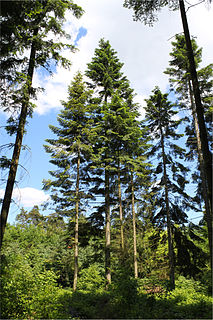
Abies grandis is a fir native to the Pacific Northwest and Northern California of North America, occurring at altitudes of sea level to 1,800 m. It is a major constituent of the Grand Fir/Douglas Fir Ecoregion of the Cascade Range.
This shrub is a pioneer species that increases after disturbance and decreases as the overstory grows back and shades it out. It grows rapidly after events such as wildfire, sprouting up from its rhizomes. It is considered a "fire-resistant" plant. It survives fire and resprouts, becoming more common on burned sites than unburned. [2]
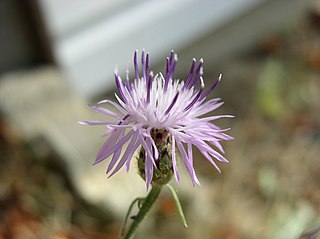
Pioneer species are hardy species which are the first to colonize previously biodiverse steady-state ecosystems. Some lichens grow on rocks without soil, so may be among the first of life forms, and break down the rocks into soil for plants. Since some uncolonized land may have thin, poor quality soils with few nutrients, pioneer species are often hardy plants with adaptations such as long roots, root nodes containing nitrogen-fixing bacteria, and leaves that employ transpiration. Note that they are often photosynthetic plants, as no other source of energy except light energy is often available in the early stages of succession, thus making it less likely for a pioneer species to be non-photosynthetic. The plants that are often pioneer species also tend to be wind-pollinated rather than insect-pollinated, as insects are unlikely to be present in the usually barren conditions in which pioneer species grow; however, pioneer species tend to reproduce asexually altogether, as the extreme or barren conditions present make it more favourable to reproduce asexually in order to increase reproductive success rather than invest energy into sexual reproduction. Pioneer species will die creating plant litter, and break down as "leaf mold" after some time, making new soil for secondary succession, and nutrients for small fish and aquatic plants in adjacent bodies of water.

A wildfire or wildland fire is an uncontrolled fire in an area of combustible vegetation occurring in rural areas. Depending on the type of vegetation present, a wildfire can also be classified more specifically as a brush fire, bushfire, desert fire, forest fire, grass fire, hill fire, peat fire, vegetation fire, or veld fire.

In botany and dendrology, a rhizome is a modified subterranean plant stem that sends out roots and shoots from its nodes. Rhizomes are also called creeping rootstalks or just rootstalks. Rhizomes develop from axillary buds and grow horizontally. The rhizome also retains the ability to allow new shoots to grow upwards.
This is not a favored food plant among wild and domesticated herbivores. It does provide good cover for small animals. [2] The Dusky Flycatcher (Empidonax oberholseri) nests in it. [3]
This plant is known to hamper regeneration of forest habitat after disturbance such as fire or logging. It outcompetes new conifer seedlings. It is controlled with herbicide spray in some regions. [2] [3]

Logging is the cutting, skidding, on-site processing, and loading of trees or logs onto trucks or skeleton cars.




